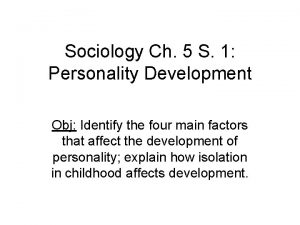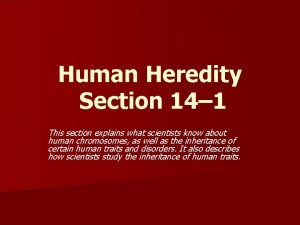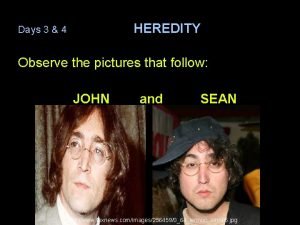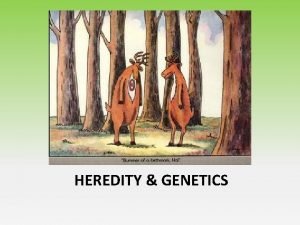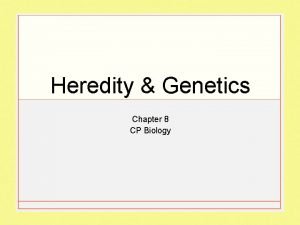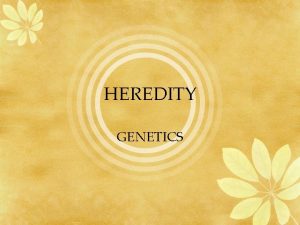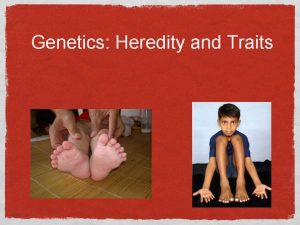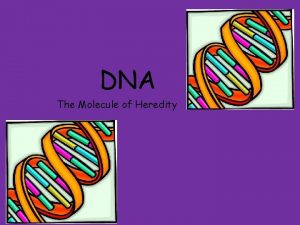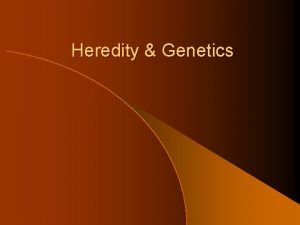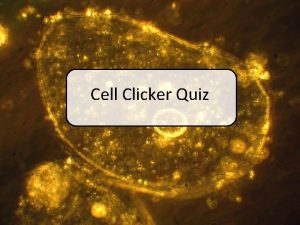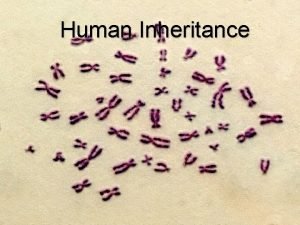Heredity Test Clicker Review Question 1 3 6





































- Slides: 37

Heredity Test Clicker Review

Question 1: (3. 6) In dogs, the allele for curly hair (H) is dominant to the allele for straight hair (h). A curly -haired male dog is crossed with a curly-haired female dog. Four of their six puppies have curly hair. Which of the following Punnett squares represents this cross? A. B. C. D.

Question 1: (3. 6) In dogs, the allele for curly hair (H) is dominant to the allele for straight hair (h). A curly -haired male dog is crossed with a curly-haired female dog. Four of their six puppies have curly hair. Which of the following Punnett squares represents this cross? A. B. D.

Question 2: (3. 6) The pictures below show two types of hairlines that children can inherit from their parents. The allele for a widow’s peak hairline (W) is dominant, and the allele for a straight hairline (w) is recessive. If both parents are heterozygous (Ww) for this trait, what is the probability that their child will have a straight hairline?

Question 2: (3. 6) The pictures below show two types of hairlines that children can inherit from their parents. The allele for a widow’s peak hairline (W) is dominant, and the allele for a straight hairline (w) is recessive. If both parents are heterozygous (Ww) for this trait, what is the probability that their child will have a straight hairline?

Question 3: (3. 4) Human HLA genes have as many as 100 different alleles per gene. The alleles code for proteins that are involved in accepting or rejecting an organ following an organ transplant. Which of the following statements explains how this multiple allele inheritance pattern makes it difficult to match an organ donor with an organ recipient?

Question 3: (3. 4) Human HLA genes have as many as 100 different alleles per gene. The alleles code for proteins that are involved in accepting or rejecting an organ following an organ transplant. Which of the following statements explains how this multiple allele inheritance pattern makes it difficult to match an organ donor with an organ recipient?

Question 4: (3. 4) A newly discovered gene has two alleles, A and a. Scientists hypothesize that the alleles show incomplete dominance. Which of the following statements provides evidence for incomplete dominance?

Question 4: (3. 4) A newly discovered gene has two alleles, A and a. Scientists hypothesize that the alleles show incomplete dominance. Which of the following statements provides evidence for incomplete dominance?

Question 5: (3. 4)

Question 5: (3. 4)

Question 6: (3. 6) In Labrador retrievers, the black fur allele (B) is dominant to the brown fur allele (b). A black male dog and a brown female dog are mated and have a litter of eight puppies. Five puppies are black and three puppies are brown. What are the genotypes of the parent dogs?

Question 6: (3. 6) In Labrador retrievers, the black fur allele (B) is dominant to the brown fur allele (b). A black male dog and a brown female dog are mated and have a litter of eight puppies. Five puppies are black and three puppies are brown. What are the genotypes of the parent dogs?

Question 7: (3. 5) Based on the results of genetic crosses, Mendel concluded that the alleles for seed color and seed shape in pea plants assorted independently. Which of the following statements best explains why the alleles for each trait assorted independently in Mendel’s experiments?

Question 7: (3. 5) Based on the results of genetic crosses, Mendel concluded that the alleles for seed color and seed shape in pea plants assorted independently. Which of the following statements best explains why the alleles for each trait assorted independently in Mendel’s experiments?

Question 8: (3. 6) A congenital cataract is a clouding of the lens of the eye that is present from birth. The mode of inheritance for one type of congenital cataract is autosomal dominant. Suppose a man is heterozygous for this type of congenital cataract, and a woman does not have cataracts. If these two individuals have a child, what is the probability that the child will have this type of congenital cataract?

Question 8: (3. 6) A congenital cataract is a clouding of the lens of the eye that is present from birth. The mode of inheritance for one type of congenital cataract is autosomal dominant. Suppose a man is heterozygous for this type of congenital cataract, and a woman does not have cataracts. If these two individuals have a child, what is the probability that the child will have this type of congenital cataract?

Question 9: (3. 4) Which of the following helps to explain why X-linked recessive traits in humans occur more frequently in males than in females?

Question 9: (3. 4) Which of the following helps to explain why X-linked recessive traits in humans occur more frequently in males than in females?

Question 10: (3. 5) In pea plants, smooth pods are dominant to wrinkled pods, and green pods are dominant to yellow pods. Two pea plants with smooth green pods are crossed. Both plants are heterozygous for pod texture and pod color. Which phenotype ratio in the offspring would best support the conclusion that the genes for pod texture and pod color are on different chromosomes?

Question 10: (3. 5) In pea plants, smooth pods are dominant to wrinkled pods, and green pods are dominant to yellow pods. Two pea plants with smooth green pods are crossed. Both plants are heterozygous for pod texture and pod color. Which phenotype ratio in the offspring would best support the conclusion that the genes for pod texture and pod color are on different chromosomes?

Question 11: (3. 4) In rabbits, a single gene with two alleles codes for ear shape. Two rabbits, each with a homozygous genotype, are mated. The female rabbit has straight ears and the male rabbit has floppy ears. All the offspring have straight ears. Which of the following conclusions about rabbit genetics is best supported by the results of the cross? O

Question 11: (3. 4) In rabbits, a single gene with two alleles codes for ear shape. Two rabbits, each with a homozygous genotype, are mated. The female rabbit has straight ears and the male rabbit has floppy ears. All the offspring have straight ears. Which of the following conclusions about rabbit genetics is best supported by the results of the cross?

Question 12: (3. 6) Fruit flies have hair-like bristles on the back side of their bodies. The bristles can be long or short. Flies with short bristles have two recessive alleles (ss) for the trait. A fruit fly that is heterozygous for the bristle trait is crossed with a fruit fly that has short bristles. The cross produces 220 offspring. How many of the offspring are expected to have short bristles?

Question 12: (3. 6) Fruit flies have hair-like bristles on the back side of their bodies. The bristles can be long or short. Flies with short bristles have two recessive alleles (ss) for the trait. A fruit fly that is heterozygous for the bristle trait is crossed with a fruit fly that has short bristles. The cross produces 220 offspring. How many of the offspring are expected to have short bristles?

Question 13: (3. 4) In a plant called jimsonweed, flowers can be white or purple. A jimsonweed plant with white flowers is crossed with a jimsonweed plant with purple flowers. All of the offspring have purple flowers. Based on the results of the cross, which of the following statements most likely describes the alleles for flower color in jimsonweed?

Question 13: (3. 4) In a plant called jimsonweed, flowers can be white or purple. A jimsonweed plant with white flowers is crossed with a jimsonweed plant with purple flowers. All of the offspring have purple flowers. Based on the results of the cross, which of the following statements most likely describes the alleles for flower color in jimsonweed?

Question 14: (3. 5) In guinea pigs, the allele for black hair (B) is dominant to the allele for brown hair (b). The allele for short hair (S) is dominant to the allele for long hair (s). The genes for hair color and hair length are located on different chromosomes. Guinea pigs with black, short hair (Bb. Ss) are crossed with guinea pigs with brown, long hair (bbss). Some offspring have black, short hair or brown, long hair like the parents. Additionally, some offspring have black, long hair or brown, short hair. Which of the following explains the different phenotypes in the offspring?

Question 14: (3. 5) In guinea pigs, the allele for black hair (B) is dominant to the allele for brown hair (b). The allele for short hair (S) is dominant to the allele for long hair (s). The genes for hair color and hair length are located on different chromosomes. Guinea pigs with black, short hair (Bb. Ss) are crossed with guinea pigs with brown, long hair (bbss). Some offspring have black, short hair or brown, long hair like the parents. Additionally, some offspring have black, long hair or brown, short hair. Which of the following explains the different phenotypes in the offspring?

Question 15: (3. 5) Which of the following laws or principles states that the two alleles of a gene pair separate during gamete formation?

Question 15: (3. 5) Which of the following laws or principles states that the two alleles of a gene pair separate during gamete formation?

Question 16: (3. 4)

Question 16: (3. 4)

Question 17: (3. 6) Many ranchers prefer cattle without horns. The presence or absence of horns is genetically determined. The allele for the absence of horns (A) is dominant to the allele for the presence of horns (a). A male with horns is mated with a heterozygous female without horns. What percentage of the offspring would be expected to have horns?

Question 17: (3. 6) Many ranchers prefer cattle without horns. The presence or absence of horns is genetically determined. The allele for the absence of horns (A) is dominant to the allele for the presence of horns (a). A male with horns is mated with a heterozygous female without horns. What percentage of the offspring would be expected to have horns?

Question 18: (3. 5) In garden pea plants, the tall allele (T) is dominant to the short allele (t), and the round seed allele (R) is dominant to the wrinkled seed allele (r). Which of the following crosses could produce short pea plants with wrinkled seeds?

Question 18: (3. 5) In garden pea plants, the tall allele (T) is dominant to the short allele (t), and the round seed allele (R) is dominant to the wrinkled seed allele (r). Which of the following crosses could produce short pea plants with wrinkled seeds?
 Costa question levels
Costa question levels Chapter 11 complex inheritance and human heredity test
Chapter 11 complex inheritance and human heredity test Math clicker
Math clicker E clicker
E clicker Audience response clicker
Audience response clicker Lesson 5 building an app clicker game
Lesson 5 building an app clicker game Earth clicker
Earth clicker Maximal heart rate
Maximal heart rate Hitler clicker
Hitler clicker Clicker stop motion
Clicker stop motion Cooi clicker
Cooi clicker Umbc clicker
Umbc clicker Clicker box
Clicker box Youtube youtube
Youtube youtube Clicker stop motion
Clicker stop motion Clicker
Clicker Phys 172
Phys 172 Buzka clicker
Buzka clicker Salt clicker
Salt clicker Clicker gravel transport
Clicker gravel transport Atomic clicker
Atomic clicker Click the spacebar
Click the spacebar Fibonacci clicker
Fibonacci clicker Clicker
Clicker Presentation clicker challenger
Presentation clicker challenger Sohcahtoa rule
Sohcahtoa rule Atomic clicker
Atomic clicker Clicker fungus
Clicker fungus Clicker questions physics
Clicker questions physics Unit test review algebra 2
Unit test review algebra 2 Genetic vocabulary worksheet answer key
Genetic vocabulary worksheet answer key Heredity characteristics include body build
Heredity characteristics include body build Mendelian genetics concept map
Mendelian genetics concept map Section 3 mendel and heredity
Section 3 mendel and heredity 14-1 human heredity
14-1 human heredity Heredity is best described as
Heredity is best described as Pictures of heredity
Pictures of heredity Heredity examples
Heredity examples































